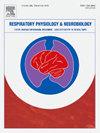The role of the midbrain tegmentum in the regulation of breathing patterns in carp (Cyprinus carpio) and trout (Onchorhynchus mykiss)
IF 1.6
4区 医学
Q3 PHYSIOLOGY
引用次数: 0
Abstract
In vertebrates, the basic respiratory rhythm is modified by both sensory feedback and input from higher centers to produce a broad range of breathing patterns. In carp (Cyprinus carpio L.), breathing is often episodic while in trout (Onchorhynchus mykiss) it is continuous and rhythmic except when water is hyperoxic. A previous study in carp revealed that stimulation of neurons at a site in the dorsal mesencephalic tegmentum (DMT) ventrolateral to the oculomotor nucleus, can terminate the apneas and initiate breathing episodes (Juch and Ballintijn, 1983). Such stimulation, however, did not eliminate the apneas or the breathing episodes. To determine whether this site also contains neurons involved in initiating periods of apnea that are intrinsic to episodic breathing, we attempted to lesion the DMT site in decerebrate, spinalectomized carp and trout using stereotaxic microinjections of 0.01 mM kainic acid. Following decerebration and spinalectomy, 93 % of carp and 33 % of trout breathed in episodes in hyperoxic water. Kainic acid injections initially stimulated breathing in all fish. As the excitotoxic effects progressed, breathing frequency and breath amplitude returned to normal levels suggesting that sites within the areas we lesioned are not involved in establishing the overall level of respiratory drive. The ensuing lesions, however, eliminated the episodic breathing in hyperoxia in over 50 % of the carp and 33 % of the trout. This suggests that sites within the midbrain tegmentum are involved in establishing breathing patterns and that there is a non-uniform distribution of neurons within the midbrain tegmentum involved in producing apneas and clustering breaths into episodes.
中脑被盖在鲤鱼和鳟鱼呼吸模式调节中的作用。
在脊椎动物中,基本的呼吸节奏被感觉反馈和来自更高中枢的输入所修改,从而产生范围广泛的呼吸模式。鲤鱼(Cyprinus carpio L.)的呼吸通常是断断续续的,而鳟鱼(Onchorhynchus mykiss)的呼吸是连续的和有节奏的,除非水是高氧的。先前对鲤鱼的一项研究表明,刺激动眼核腹侧的中脑背被(DMT)的一个部位的神经元,可以终止呼吸暂停并引发呼吸发作(Juch和Ballintijn, 1983)。然而,这种刺激并不能消除呼吸暂停或呼吸发作。为了确定该部位是否也包含与间歇性呼吸所固有的呼吸暂停启动期有关的神经元,我们尝试用立体定向显微注射0.01mM的kainic酸来损伤去脑、去脊髓的鲤鱼和鳟鱼的DMT部位。在去脑和脊柱切除后,93%的鲤鱼和33%的鳟鱼在高氧水中发作呼吸。Kainic酸注射最初刺激了所有鱼的呼吸。随着兴奋性毒性作用的进展,呼吸频率和呼吸幅度恢复到正常水平,这表明我们损伤的区域内的部位不参与建立呼吸驱动的总体水平。然而,随后的损伤消除了50%以上的鲤鱼和33%的鳟鱼的间歇性高氧呼吸。这表明中脑被盖内的部位参与了呼吸模式的建立,中脑被盖内的神经元分布不均匀,参与了呼吸暂停的产生和呼吸聚集成几次。
本文章由计算机程序翻译,如有差异,请以英文原文为准。
求助全文
约1分钟内获得全文
求助全文
来源期刊
CiteScore
4.80
自引率
8.70%
发文量
104
审稿时长
54 days
期刊介绍:
Respiratory Physiology & Neurobiology (RESPNB) publishes original articles and invited reviews concerning physiology and pathophysiology of respiration in its broadest sense.
Although a special focus is on topics in neurobiology, high quality papers in respiratory molecular and cellular biology are also welcome, as are high-quality papers in traditional areas, such as:
-Mechanics of breathing-
Gas exchange and acid-base balance-
Respiration at rest and exercise-
Respiration in unusual conditions, like high or low pressure or changes of temperature, low ambient oxygen-
Embryonic and adult respiration-
Comparative respiratory physiology.
Papers on clinical aspects, original methods, as well as theoretical papers are also considered as long as they foster the understanding of respiratory physiology and pathophysiology.

 求助内容:
求助内容: 应助结果提醒方式:
应助结果提醒方式:


